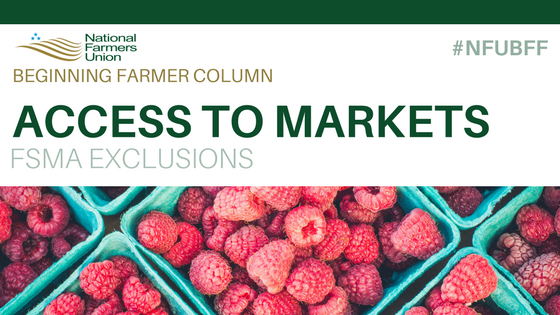 By Barbara Patterson, NFU Director of Government Relations, and Roger Noonan, New England Farmers Union President
By Barbara Patterson, NFU Director of Government Relations, and Roger Noonan, New England Farmers Union President
A few weeks ago, we shared the Food Safety Modernization Act (FSMA) Needs Assessment Survey here on the Beginning Farmer Forum (BFF). This week, BFF will cover another FSMA-related topic: what is excluded or exempt from the Produce Safety Rule, which sets regulatory standards for the production, harvest, and handling of fruits and vegetables. For the purposes of brevity, we’ll refer to the Produce Safety Rule as just “the rule.”
But first, let’s define “farm” as the U.S. Food and Drug Administration (FDA) sees it. The rule includes two farm definitions.
The first, “primary production,” refers to the farm you operate – whether you own, rent or squat – regardless of your business structure – sole proprietor, LLC, co-op, etc. Primary production operations’ land and associated buildings are in one general location, though not necessarily contiguous. On that land, you are devoted to the growing and harvesting of crops, raising animals (including seafood), or any combination of those activities. Being a “farm” allows for certain activities beyond exclusively growing and harvesting, such as light processing, and the definition recognizes the very diverse business models and post-harvest activities of small- and mid-sized farms serving local foods markets.
The second definition, “secondary activities farm,” has created a fair amount of consternation. A secondary activities farm allows for primary production farmers to have jointly-owned packing houses for aggregation and distribution and/or post-harvesting handling operations independent of their primary farms, provided that either the primary farms also grow, harvest, and/or raise the majority of the raw agricultural products that are harvested, packed, and/or held at the secondary activities operation, or the operators of the primary farms own a majority interest in the secondary activities farm. For example, a farmer-owned coop that has cold storage and a bagging facility but is not located on any of the primary production farms would be considered a secondary activity farm. Secondary activities farms may conduct the activities, such as packaging and processing, allowed at primary farms.
Either type of farm is exempt from facility registration under the Bioterrorism Act. If a farm conducts processing activities not allowed under the farm definition, it is classified as a farm mixed-type facility, but we’ll save that for another post.
After reading all of that, you have determined that you operate a farm. Now what?
Some farms may not be covered by the new FSMA produce regulations. There are several exemptions included in the regulations, but they can be a bit confusing. If you do any on- or off-farm processing, stay tuned for a separate blog post on that. In addition, if you grow any feed for animals, you may be subject to the Animal Feed Rule, which we will also cover in a separate post.
The rule does not apply to:
- Produce that is not a raw agricultural commodity (RAC). A RAC is any food in its raw or natural state. Unlike RAC, produce that undergoes sufficient processing to reduce pathogens is excluded from the rule. There are important action steps for the grower/seller, the buyer, and/or processor to follow to meet the “Not a RAC” requirements.
- First, the farmer must provide written disclosure that the food is “not processed to adequately reduce the presence of microorganisms of public health significance” and
- Second, the farmer must annually obtain written assurance from the customer that performs the commercial processing or an intermediary buyer
- If you currently sell canning tomatoes to Red Gold or Heinz, for example, you likely already have documents that satisfy the requirements.
- Keep in mind, these disclosures are only required if you are claiming an exclusion from the rule for produce that receives commercial processing that has a kill step.
- Produce commodities that FDA considers “rarely consumed raw.” There is an exhaustive list of those on FDA’s FSMA website, but for reference, it includes foods like chickpeas, sweet potatoes, and winter squash.
- Food grains like barley, sorghum, oats, and rye.
- Produce that is used for personal or on-farm consumption.
- Farms that have an average annual value of produce sold during the previous three-year period of $25,000 (adjusted for inflation) or less. See below for more information on how to calculate this.
If any of the above applies, you are excluded from the rule. However, food safety is still important, even for exempt operations! Buyers or state requirements may require that farmers demonstrate compliance with the regulations, so NFU recommends becoming familiar with both state requirements and the basics of FSMA compliance.
If you fall under the $25,000 threshold, while it is not required, you may want to keep records on hand that demonstrate your exemption.
If you have more questions about exemptions, you may find this presentation from Cornell University helpful.
Calculating your average annual produce gross sales
Under FSMA, if a farm is excluded (under $25,000 in 2011 dollars, which is currently $26,632, in average annual produce gross sales), the farmer must document their exclusion from the rule using sales records averaged over the last three years. The threshold for exclusion is based on $25,000 in 2011 dollars, which is currently $26,632. Each March, FDA will update the number here.
If actual sales data is unavailable, an estimate should be made.
While the rule may not apply to you, it is up to you to retain and show the appropriate documents to support your exemption. Make sure to check out compliance dates on the FDA website.
Follow us at localfoodsafety.org, where next week, we will walk through qualified exemptions.
Like what you’ve read? Check out our Beginning Farmer Forum home page, and join the conversation in the Beginning Farmer Forum Facebook group.